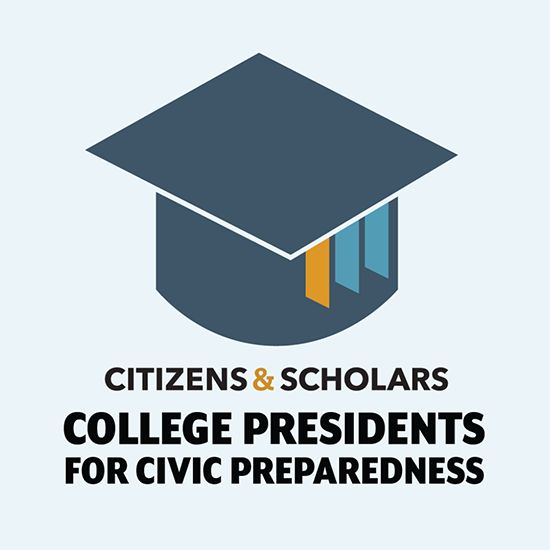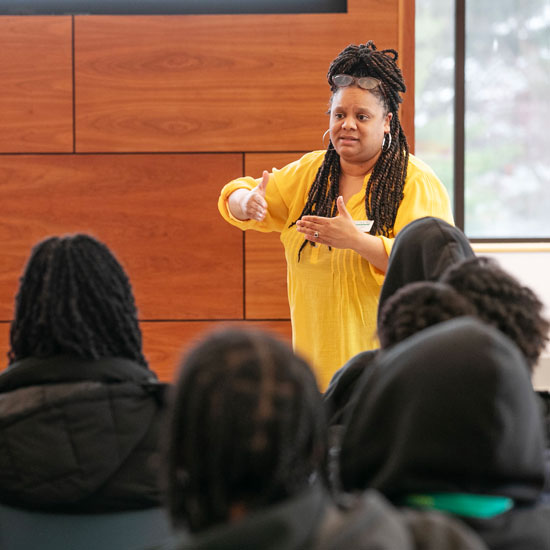A merger of art and science
Design and computer programming used to look like totally separate disciplines. No longer, as a new approach to teaching interactive design shows.
Design education has to change with the times, says Deb Hall, associate professor of art.
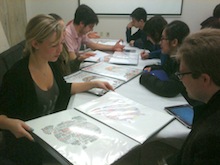
'Speed dating': Designers and
programmers shared portfolios,
then formed project teams
“Designers are no longer designing in just two dimensions for print; they’re designing for screens on Web sites, tablets and smart phones. More and more, they’re also working with programmers, and that means knowing how to work with others on creative teams.”
Hall has been working with the Department of Mathematics and Computer Science for the last three years with the aim of narrowing the curricular gap between art and programming. This spring, the two departments took a major step toward that end.
Most importantly, they aligned Hall’s “Interactive Design” art course (AR351) with associate professor of computer science Michael Eckmann’s “Programming for Interactive Design” course (CS277) so that students in both classes were able to spend three hours together most Tuesday afternoons working on joint projects. At a “speed dating” session early in the semester, designers and programmers shared portfolios and resumes and paired up in teams in which they jointly tackled various design assignments requiring the use of HTML and CSS and programming languages Javascript and ActionScript 3.
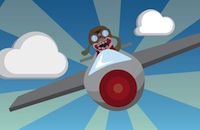
Joe Klockowski '13 produced
this image for 'Cardboard Pilot'
The departments also joined with the Career Development Center and Office of Communications in bringing back to the campus in April four alumni who have established highly successful careers in interactive design: independent game developer Zach Gage ’07; Jonathan Hills, founder and creative director of DOMANI, a prominent digital marketing agency based in New York; Charlie Whitney ’06, an award-winning freelance programmer, and Brian Kelley ’00, a serial entrepreneur who cofounded ReputationDefender.com (now known as Reputation.com).
In addition to giving students their perspectives on the dynamics of the relationship between designers and programmers, the alumni talked a lot about games, inspiring a number of the student teams to develop games of their own.
Here are a few they came up with:
- Cardboard Pilot, designed by Joe Klockowski ‘13 and developed by Tom Wagner ’13. See how many balloons you can shoot down before your plane is blown out of the sky by bomb-carrying parachutes.
- Asian Evasion, designed by Siwei Song ’14 and developed by Ethan Formichella ’14. See how far you can run before being ensnared in a giant dim sum and swallowed by the “mean old lady” down the street.
- Pop ‘em, designed by Dan Pinnolis ‘13 and developed by Conor Mullen ‘14. See how many points you can rack up by shooting balloons with a cannon. (Be careful not to hit the birds.)
- Squirrel Game, designed by Megan Mulone ’13 and developed by Robin Luongo ‘15. Help the Skidmore Squirrel get across the Case walkway.
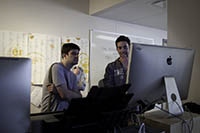
Indy game developer Zach
Gage '07 discusses a design
with Dan Pinnolis '13
“I think there was an expectation that the art students would bring the vision and produce the cool sketches and the programmers would just try to build whatever they came up with,” notes Isaac Chansky ’13, who assisted Hall in developing her course and stayed on as a teaching assistant.For another assignment, the student teams also developed, researched, wrote, designed and produced “articles” for a visually compelling e-magazine designed specifically for iPad. Generously packed with original photo albums, video, and audio, Creativity Matters – which can be accessed as an app at no charge in the iPad Apps Store -- takes full advantage of the highly interactive platform on which it sits, offering profiles of such artists as Carrie Moyer, whose paintings were exhibited earlier this year at the Tang Museum; Sang-Wook Lee, associate professor of art at Skidmore; and Pulse, Skidmore’s found object percussion group.
“But that’s not what happened. In many cases, the artists’ sketches touched off a feedback loop in which programmers came up with ideas for the art and artists came up with ideas for interaction. Computer science students learned something about design and the visual psychology of their products, while artists lost some of their fear of programming and actually did some simple coding.”
Now a developer with a Boston-based start-up company, Chansky says he hopes the art and computer science departments will find more ways for students to interact in teams.
“To collaborate with someone who has a totally different way of viewing an interaction on the Web or iPad is a very valuable experience. It really makes you think about what you’re doing.”
